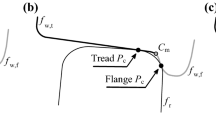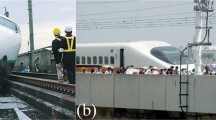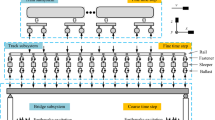Abstract
A realistic simulation of train derailment is crucial when assessing the safety of a train running over a bridge during earthquake excitation. This paper presents a seismic vehicle–bridge interaction analysis that simulates directly different wheel–rail contact states including flange contact, detachment, uplifting, wheel–rail climbing-up, recontact, and ultimately, derailment. The proposed model determines the contact point and the direction of the contact forces over practical nonlinear profiles of wheels and rails. It then classifies the wheel–rail contact, as double contact, single contact or double detachment, and tackles accordingly the kinematics. The modeling of the wheel–rail contact along the normal direction hinges upon the principles of nonsmooth dynamics and accounts for continuous contacts of finite duration, impacts (instantaneous duration) and transitions from continuous contacts to detachments. The modeling of the tangential contact forces follows the nonlinear creep theory. The results verify that well-known force-based metrics such as derailment factor and offload factor yield conservative estimations of train operational safety. The analysis stresses the key role of flange contact under a large contact angle that could lead to the detachment of the other wheel of the same wheelset, and underlines the importance of a more realistic train–bridge interaction modeling during earthquakes. For the examples examined, which involve a complete three-dimensional vehicle running on simply supported bridge units, derailment occurs when a wheel rolls over the rail head (wheel–rail climbing-up). The results unveil that both the amplitude and the frequency of the earthquakes are important to the safety of trains running over bridges.















Similar content being viewed by others
References
http://en.wikipedia.org/wiki/High-speed_railway_in_China (2015). Accessed 08 Oct 2017
Yan, B., Dai, G.L., Hu, N.: Recent development of design and construction of short span high-speed railway bridges in China. Eng. Struct. 100, 707–717 (2015)
https://en.wikipedia.org/wiki/Danyang%E2%80%93Kunshan_Grand_Bridge (2015). Accessed 08 Oct 2017
Zeng, Q., Dimitrakopoulos, E.G.: Seismic response analysis of an interacting curved bridge–train system under frequent earthquakes. Earthq. Eng. Struct. Dyn. 45, 1129–1148 (2016)
Ogura, M.: The Niigata Chuetsu Earthquake–railway response and reconstruction. Jpn. Railw. Transp. Rev. 43, 46–63 (2006)
Ju, S.H.: Nonlinear analysis of high-speed trains moving on bridges during earthquakes. Nonlinear Dyn. 69(1), 173–183 (2012)
http://www.asahi.com/ajw/articles/AJ201604150055.html (2016). Accessed 08 Oct 2017
Yang, Y.B., Wu, Y.S.: Dynamic stability of trains moving over bridges shaken by earthquakes. J. Sound Vib. 258(1), 65–94 (2002)
Xia, H., Han, Y., Zhang, N., Guo, W.W.: Dynamic analysis of train–bridge system subjected to non-uniform seismic excitations. Earthq. Eng. Struct. Dyn. 35(12), 1563–1579 (2006)
Du, X.T., Xu, Y.L., Xia, H.: Dynamic interaction of bridge–train system under non-uniform seismic ground motion. Earthq. Eng. Struct. Dyn. 41(1), 139–157 (2012)
Cheng, Y.C., Chen, C.H., Hsu, C.T.: Derailment and dynamic analysis of tilting railway vehicles moving over irregular tracks under environment forces. Int. J. Struct. Stab. Dyn. 17(9), 1750098-1-27 (2017)
Nishimura, K., Terumichi, Y., Morimura, T., Sogabe, K.: Development of vehicle dynamics simulation for safety analyses of rail vehicles on excited tracks. J. Comput. Nonlinear Dyn. 4(1), 011001 (2009)
Tanabe, M., Wakui, H., Sogabe, M., Matsumoto, N., Tanabe, Y.: An efficient numerical model for dynamic interaction of high speed train and railway structure including post-derailment during an earthquake. In: 8th International Conference on Structural Dynamics, EURODYN. Leuven, Belgium, pp. 1217–1223 (2011)
Jin, Z.B., Pei, S.L., Li, X.Z., Liu, H.Y., Qiang, S.Z.: Effect of vertical ground motion on earthquake-induced derailment of railway vehicles over simply-supported bridges. J. Sound Vib. 383, 277–294 (2016)
Nadal, M.J.: Theorie de la stabilite des locomotives, part 2: mouvement de lacet’. 10, 232–255 (1896)
Wu, X.W., Chi, M.R., Gao, H.: Post-derailment dynamic behaviour of a high-speed train under earthquake excitations. Eng. Fail. Anal. 64, 97–110 (2016)
Weinstock, H.: Wheel climb derailment criteria for evaluation of rail vehicle safety. In: Proceeding of the ASME Winter Annual Meeting, New York, pp. 1–7 (1984)
Shabana, A.A., Zaazaa, K.E., Sugiyama, H.: Railroad Vehicle Dynamics: A Computational Approach. CRC Press, New York (2010)
Luo, X.: Study on methodology for running safety assessment of trains in seismic design of railway structures. Soil Dyn. Earthq. Eng. 25(2), 79–91 (2005)
http://www.chinapost.com.tw/taiwan/national/national-news/2010/03/05/246940/HSR-service.htm (2010). Accessed 08 Oct 2017
Ju, S.H.: A frictional contact finite element for wheel/rail dynamic simulations. Nonlinear Dyn. 85(1), 365–374 (2016)
Comité Europeen de Normalization.: Eurocode 8: design of structures for earthquake resistance-part 2: Bridges. 2, 2003 (1998)
Cook, R.D.: Concepts and Applications of Finite Element Analysis. Wiley, New York (2007)
Chopra, A.K.: Dynamics of Structures: Theory and Applications to Earthquake Engineering. Prentice Hall, Upper Saddle River (2000)
Yang, Y.B., Wu, Y.S., Yao, Z.D.: Vehicle–Bridge Interaction Dynamics: With Applications to High-Speed Railways. World Scientific, Singapore (2004)
Antolín, P., Zhang, N., Goicoleaa, J.M., Xia, H., Astiza, M.Á., Olivaa, J.: Consideration of nonlinear wheel–rail contact forces for dynamic vehicle–bridge interaction in high-speed railways. J. Sound Vib. 332, 1231–1251 (2013)
Zeng, Q., Yang, Y.B., Dimitrakopoulos, E.G.: Dynamic response of high speed vehicles and sustaining curved bridges under conditions of resonance. Eng. Struct. 114, 61–74 (2016)
Dimitrakopoulos, E.G., Zeng, Q.: A three-dimensional dynamic analysis scheme for the interaction between trains and curved railway bridges. Comput. Struct. 149, 43–60 (2015)
Zeng, Q.: Analysis and Simulation of the Vehicle-Bridge-Interaction in Horizontally Curved Railway Bridges. The Hong Kong University of Science and Technology, Degree of Doctor of Philosophy in Civil Engineering (2016)
Carter, F.W.: On the action of a locomotive driving wheel. In: Proceedings of the Royal Society of London A: Mathematical, Physical and Engineering Sciences. London, UK, pp. 151–157 (1926)
Shen, Z.Y., Hedrick, J.K., Elkins, J.A.: A comparison of alternative creep force models for rail vehicle dynamic analysis. Veh. Syst. Dyn. 12(1–3), 79–83 (1983)
Kalker, J.J.: Three-Dimensional Elastic Bodies in Rolling Contact. Springer, Berlin (1990)
Shi, Z.Q., Dimitrakopoulos, E.G.: Nonsmooth dynamics prediction of measured bridge response involving deck abutment pounding. Earthq. Eng. Struct. Dyn. https://doi.org/10.1002/eqe.2863 (2017)
Dimitrakopoulos, E.G.: Analysis of a frictional oblique impact observed in skew bridges. Nonlinear Dyn. 60(4), 575–595 (2010)
Theodosiou, C., Natsiavas, S.: Dynamics of finite element structural models with multiple unilateral constraints. Int. J. Non-Linear Mech. 44(4), 371–382 (2009)
Pfeiffer, F., Glocker, C.: Multibody Dynamics with Unilateral Contacts. Wiley, Singapore (1996)
Dimitrakopoulos, E.G.: Nonsmooth analysis of the impact between successive skew bridge-segments. Nonlinear Dyn. 74(4), 911–928 (2013)
Giouvanidis, A.I., Dimitrakopoulos, E.G.: Nonsmooth dynamic analysis of sticking impacts in rocking structures. B Earthq. Eng. (2016). https://doi.org/10.1007/s10518-016-0068-4
Glocker, C., Cataldi-Spinola, E., Leine, R.I.: Curve squealing of trains: measurement, modelling and simulation. J. Sound Vib. 324(1), 365–386 (2009)
Antolín, P., Goicolea, J.M., Astiz, M.A.l., Alonso, A.: A methodology for analysing lateral coupled behavior of high speed railway vehicles and structures. In: IOP Conference Series: Materials Science and Engineering. Sidney, Australia, p. 012001 (2010)
Montenegro, P.A., Neves, S.G.M., Calada, R., Tanabe, M., Sogabe, M.: Wheel–rail contact formulation for analyzing the lateral train-structure dynamic interaction. Comput. Struct. 152, 200–214 (2015)
MathWorks: MATLAB User’s Guide. The MathWorks Inc., Natick, MA (1994–2013)
Shampine, L.F., Reichelt, M.W.: The matlab ode suite 18(1), 1–22 (1997)
http://ngawest2.berkeley.edu/site (2015). Accessed 08 Oct 2017
Kim, C.W., Kawatani, M.: Effect of train dynamics on seismic response of steel monorail bridges under moderate ground motion. Earthq. Eng. Struct. Dyn. 35(10), 1225–1245 (2006)
China’s Ministry of Railways, Code for Design of High Speed Railway (2009)
Iwnicki, Simon: Handbook of Railway Vehicle Dynamics. CRC Press, Boca Raton (2006)
Dimitrakopoulos, E.G., Giouvanidis, A.I.: Seismic response analysis of the planar rocking frame. J. Eng. Mech. 141(7), 04015003 (2015)
Mavroeidis, G.P., Papageorgiou, A.S.: A mathematical representation of near-fault ground motions. Bull. Seismol. Soc. Am. 93(3), 1099–1131 (2003)
Acknowledgements
This study was supported by Research Grants Council 2016, Hong Kong, the People’s Republic of China, under Contract Number: 16244116.
Author information
Authors and Affiliations
Corresponding author
Appendices
Appendix A
The diagonal mass matrix of a single vehicle is [26]:
Sub-matrices in \({{\mathbf{M}}^V}\) are:
and
The partitioned stiffness matrix is given as:
The nonzero entries in the partitioned matrix are:
where
Replacing ‘k’ in the corresponding sub-stiffness matrix with ‘c’, the damping matrix \({{\mathbf{C}}^V}\) is identical in form with the stiffness matrix \({{\mathbf{K}}^V}\) [26].
The contact direction matrices for the upper parts of the vehicle (car body and bogies) are zero. The nonzero normal contact direction matrix of a single wheelset in Eq. (9) is given as [29]:
The nonzero contact direction matrix of a single wheelset \({{\mathbf{W}}_T}^{wi}\) corresponding to the longitudinal and the lateral creep forces (\({{\lambda _{Tx}}^i}\) and \({{\lambda _{Ty}}^i}\)) and the spin moment (\({{\lambda _{Mz}}^i}\)) is given as:
with
and
where the contact parameters \(\delta _L\) and \(\delta _R\) are the contact angles of the left (L) wheel and the right (R) wheel; \(r_L\) and \(r_R\) are the actual rolling radii; and \(l_{aL}\) and \(l_{aR}\) are the half-contact width of the left and the right wheels (Fig. 5b). Abbreviations ‘s’ and ‘c’ denote the ‘sin’ and the ‘cos’ functions.
Table 3 lists the properties of the vehicle model [25]:
Appendix B
See Table 4.
Rights and permissions
About this article
Cite this article
Zeng, Q., Dimitrakopoulos, E.G. Vehicle–bridge interaction analysis modeling derailment during earthquakes. Nonlinear Dyn 93, 2315–2337 (2018). https://doi.org/10.1007/s11071-018-4327-6
Received:
Accepted:
Published:
Issue Date:
DOI: https://doi.org/10.1007/s11071-018-4327-6




